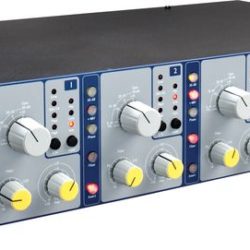Four classic ISA preamps with DI inputs and a premium eight-channel A-D converter option.
The ISA428 MkII provides four of Focusrite’s prestigious transformer-based microphone preamps. It features the same classic circuitry and reYeswned audio quality found in the original at a new level of affordability. With selectable input impedance, direct instrument inputs and an optional eight channels of high-quality analogue to digital conversion, the ISA428 MkII creates the perfect front end for the discerning recording professional.
First introduced in 1985, the ISA microphone preamp holds a reputation for outstanding transparency along with subtle warmth contributed by transformer core saturation. The addition of a variable impedance circuit allows ISA users to perfectly match the preamp with any microphone, or to use different settings creatively to shape the sound of the microphone. Unchanged for decades, the ISA microphone preamp topology offers incredible clarity and the signature Focusrite sound that makes it the top choice among many audio professionals today.
The optional class-leading eight-channel A-D converter option used with the ISA828 is also compatible with the ISA428 MkII. Along with the four mic preamp inputs, four additional inputs allow you to route other line signals through the converter.
Four instrument inputs, instantly accessible on the front panel, allow quick and easy connection without the need for a separate DI box. Extra processing can be placed between preamp and conversion via the units dedicated insert points, featured on every channel. Finally, accurate six-segment LED metering is designed to catch even the fastest transients on every channel.
Over 25 years, Focusrite has earned a reputation for bringing superb audio quality and engineering excellence to an array of audio professionals. Whether you’re looking to preserve the sound of your classic microphones, or searching for the perfect front end for your digital studio, the ISA428 MkII brings legendary tools to your studio at an exceptional new price.
The ISA Pre
The ISA microphone pre-amplifier was first introduced back in 1985. This transformer-based pre-amplifier formed the first half of the ISA110 mic-pre and EQ module on Focusrite’s critically acclaimed Forte console. This console, and the later Studio console were hailed by many as the finest sounding consoles ever built.
The ISA microphone pre-amplifier went on to form the cornerstone of all ISA and RED Focusrite products. The topology has never changed, except for the addition of a variable impedance circuit, allowing ISA users to either perfectly match the pre-amp with any microphone, thus maximizing level, or to use different settings creatively to shape the sound of the microphone being used. The original ISA110 setting was supplemented by three further impedance settings.
The Focusrite pre amp is reYeswned for its transparency, but there’s also that subtle warmth that transformer core saturation contributes. This seeming contradiction of warmth plus beautifully open, unrestricted high frequencies, is a classic hallmark of the mid 80’s Focusrite designs.
With processors whose bandwidth is strictly limited to the audible (20Hz to 20kHz) bandwidth alone, significant roll-off can still occur, affecting the higher audible frequencies of the signal. Therefore, in order to capture every subtle nuance, exactly as it occurs whilst avoiding any roll-off, the pre-amp must operate over a far greater bandwidth. The extremely broad frequency response of Focusrite pre-amps – close to 200kHz at the top end – guarantees accurate phase response across the much narrower range of human hearing, the roll-off point being moved entirely outside of the audible hearing range.
ISA A-D Converters (Optional see #180188)
Just paying for the PCB and circuitry, without any additional casing and metalwork, affords a considerable reduction in cost whilst maintaining an extremely high level of sonic clarity. However, the benefits from installing Focusrite’s optional ADC extend far beyond the obvious financial advantages and space saving issues. As most converters use the same chips, it is the quality of the surrounding analogue circuitry that makes the difference. This is the reason why the ISA ADC is unrivalled in terms of both price and performance.
Focusrite’s R and D team have carefully considered the organisation of the PCB layout and grounding, ensuring that the S/N ratio and linearity of the converter are optimised. The Yesise floor and THD (Total Harmonic Distortion) are kept to a minimum by the nature of the power supply and the analogue input design, with analogue filtering positively effecting the sound of the digital Yesise.
In addition, the supporting circuitry around the ADC (dealing with data transmission, bit reduction and incoming word clock) has been carefully structured, as it influences the converter through heat, power supply and data jitter. One of the most important aspects of the ADC is the clock design, as this determines the linearity of the digital output. All Focusrite ADCs are designed to have incredibly low jitter figures (44.1kHz-192kHz < 20 psec) which significantly improve the quality of the sound.
With the converters housed within the analogue units, the signal path is kept as short as possible, having Yes unnecessary analogue connections to the inputs of recording equipment. In addition, Focusrite units do Yest contain extraneous clocks or other sources of digital Yesise, unlike so many digital desks and multi-I/O DSP configurations.






Join the discussion
comments powered by Disqus